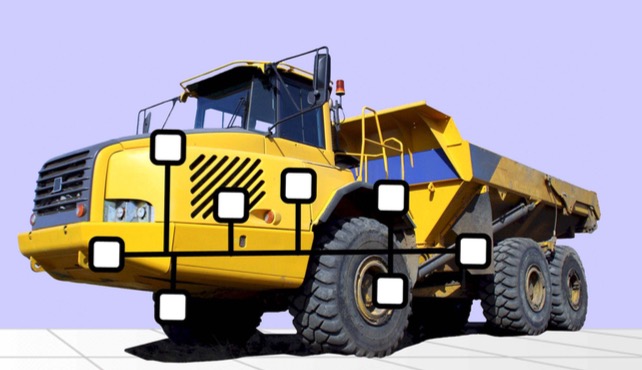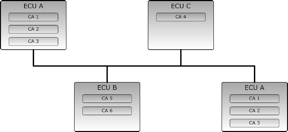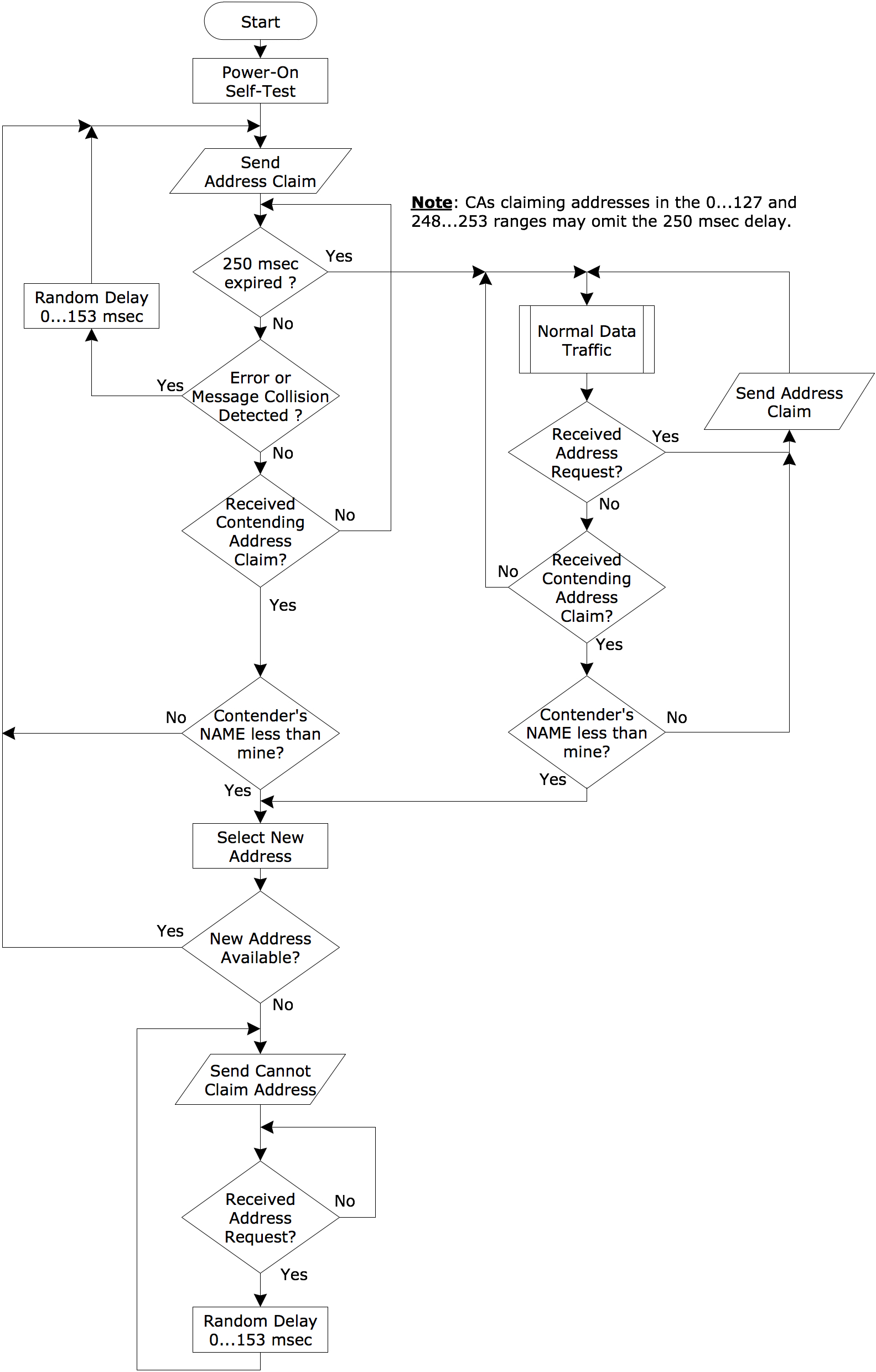Apps That Read 500 Kb J1939 Data
 Network Direction nether J1939 is primarily represented by the Address Challenge Process. While other higher layer protocols based on Controller Area Network (Can) practise not support dynamic node address assignments per default, the SAE J1939 standard provides this ingeniously designed feature to uniquely identify ECUs and their primary function.
Network Direction nether J1939 is primarily represented by the Address Challenge Process. While other higher layer protocols based on Controller Area Network (Can) practise not support dynamic node address assignments per default, the SAE J1939 standard provides this ingeniously designed feature to uniquely identify ECUs and their primary function.
SAE J1939/81 prefers the use of CA (Controller Application) rather than ECU (Electronic Control Unit of measurement). In all consequence ane ECU tin run multiple CAs. Each Controller Application will have one accost and associated Proper name. The following chapters will keep using the term ECU, which is a synonym for CA.
Address Claiming Procedure Overview
Each ECU in a J1939 vehicle network must hold at least ane Name and ane accost for identification purposes. Single electronic units are immune to command multiple names and addresses.
The 8-bit ECU address defines the source or destination for messages.
The ECU Name includes an indication of the ECU's main role performed at the ECU'south address. A function instance indicator is added in cases where multiple ECUs with the same main function share the same network.
The J1939 standard allows up to 253 ECUs with the same function to share the same network, where each ECU is identified by their individual address and NAME.
The Tin standard in itself does non support node (ECU) addresses, only message IDs, where one node may manage multiple letters. However, the message ID must be hard-coded in the application program. Also, in a standard CANopen network the node address is usually hard-wired or mechanically adaptable (eastward.g. per dip switch).
SAE J1939 defines a 64-scrap Proper name, as shown in the picture below, to uniquely identify each ECU in a network.

While the 64 fleck Name is certainly appropriate to uniquely place nodes (ECUs) and their function in a J1939 network, it will nevertheless necessitate unreasonable resource to maintain standard communications.
In order to provide a more efficient solution, the SAE J1939 Standard defines an address merits procedure, where each ECU utilizes an 8 bit address to place the source of a message or to admission (destination address) another ECU in the network. The address claim procedure is designed to assign addresses to ECUs correct later the network has been initialized and thus assuring that the assigned address is unique to the ECU. For case, an engine may be assigned the address 0 while another engine is present, which will be assigned another address (e.thou. ane) and case.
In addition, the SAE J1939 Standard defines Preferred Addresses to commonly used devices in society to minimize the charge per unit of multiple devices demanding the same address and consequently optimizing the address merits process. ECUs will mostly use their assigned Preferred Address immediately afterwards the power upward procedure, but in club to forestall any accost claim conflicts, each ECU must outset announce which addresses it intends to claim.
The address claim feature considers two possible scenarios:
- Sending an Address Claimed message
This first scenario addresses a standard J1939 network startup. Upon powering upwards (or when requested), an ECU will send an Accost Claimed message into the Can bus in gild to merits an address. All ECUs receiving the address claim will tape and verify the newly claimed accost with their internal address table. In instance of an address conflict, i.e. should ii or more ECUs merits the same address, the ECU with the lowest NAME value will succeed and use the address as claimed. The remaining ECUs must merits a different address or stop transmitting to the network.
- Request for Accost Claimed bulletin
Requesting an Address Claimed bulletin from all nodes in the network and, as a result, determining addresses claimed by other ECUs, is the necessary process for ECUs powering up late for various reasons, but especially transitional ECUs. Such transitional ECUs may exist diagnostics tools, service tools, and trailers, etc. This approach allows the ECU to determine and claim an available address or to notice out which ECUs are currently on the network.
Addresses
The J1939 protocol utilizes an viii fleck device (ECU) address, which, theoretically, would let the operation of 256 nodes in the same network. It tin but exist causeless that the SAE was trying to keep the bus traffic on a low level by restricting the maximum number of nodes to 30.
In all outcome, the ECU address is really a Controller Application accost in a situation where each ECU may arrange several Controller Applications. The 253 addresses (Address 254 is reserved for Network Management, Accost 255 is used for global addressing) are assigned (claimed) for the Controller Applications, not the actual ECU.
The following picture shows an instance, where, for case, ECU A accommodates 3 controller applications.

The picture also demonstrates that ECUs of the same part (ECU A) can co-exist in a J1939 network without accost collision. J1939 features a very ingenious feature, the Address Merits procedure which automatically assigns addresses to each Controller Application. In instance of an Address Claim disharmonize, the Controller Applications are able to claim another free address.
NULL Address
The address 254, the then-chosen Null Accost, is reserved for network direction, and it is used for the Cannot Claim Source Address message.
Global Address
The Global Address (255) is exclusively used as a destination accost in order to back up message broadcasting (sending a message to all network nodes).
Address Claim Process
The accost claim feature considers 2 possible scenarios:
- Sending an Address Claimed message
This first scenario addresses a standard J1939 network startup. Upon powering up (or when requested), an ECU will send an Address Claimed message into the CAN jitney in order to claim an address. All ECUs receiving the address claim will record and verify the newly claimed address with their internal accost table. In case of an address conflict, i.e. should two or more ECUs claim the aforementioned address, the ECU with the lowest NAME value will succeed and use the address as claimed. The remaining ECUs must claim a dissimilar accost or stop transmitting to the network.
- Asking for Address Claimed message
Requesting an Address Claimed bulletin from all nodes in the network and, as a effect, determining addresses claimed by other ECUs, is the necessary procedure for ECUs powering upwards late for diverse reasons, but especially transitional ECUs. Such transitional ECUs may be diagnostics tools, service tools, and trailers, etc. This arroyo allows the ECU to determine and claim an available address or to find out which ECUs are currently on the network.
After completing their Power On Cocky Test (Mail) ECUs (Controller Applications) challenge addresses in the 0 to 127 or 248 – 253 range may initiate their regular network activities immediately, while other ECUs should not begin until a time of 250 ms afterwards claiming an address. This allows competing claims to be resolved before the accost is being used.
In the event that two ECUs effort to merits the same address, the ECU with the lowest Name value volition succeed and use the address as claimed. The remaining ECUs must claim a different accost by sending another Address Claimed bulletin containing a different address or ship a Cannot Claim Accost message.
The destination address for an address merits is e'er the global address (255) in guild to address all nodes in the network.
A node, that has not yet claimed an address, must use the Nada accost (254) equally the source accost when sending a Request for Accost Claimed bulletin.
The following flowchart demonstrates the address merits procedure in detail:

A Comprehensible Guide to J1939
SAE J1939 has become the accustomed industry standard and the vehicle network technology of choice for off-highway machines in applications such as structure, material handling, and forestry machines. J1939 is a higher-layer protocol based on Controller Area Network (Tin can). Information technology provides series data communications between microprocessor systems (also called Electronic Control Units - ECU) in whatsoever kind of heavy duty vehicles. The messages exchanged between these units can be information such as vehicle road speed, torque command message from the manual to the engine, oil temperature, and many more.
The information in this volume is based on two documents of the SAE J1939 Standards Collection: J1939/21 - Information Link Layer J1939/81 - Network Management A Comprehensible Guide to J1939 is the first work on J1939 besides the SAE J1939 standards collection. Information technology provides profound data on the J1939 message format and network management combined with a high level of readability.
=> Read More than...
Source: https://copperhilltech.com/blog/sae-j1939-address-claim-procedure-sae-j193981-network-management/
0 Response to "Apps That Read 500 Kb J1939 Data"
Post a Comment